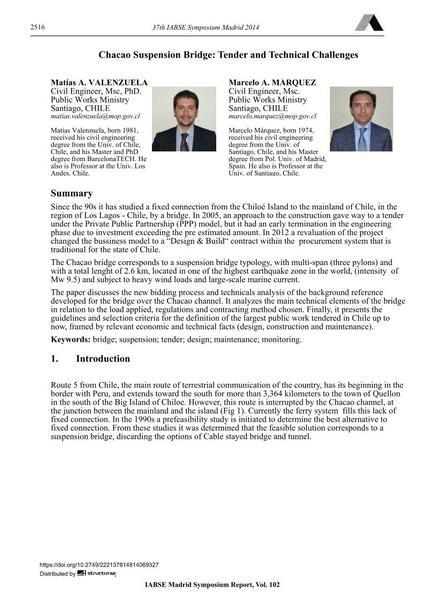Chacao Suspension Bridge: Tender and Technical Challenges

|
|
|||||||||||
Détails bibliographiques
| Auteur(s): |
Matías A. Valenzuela
Marcelo A. Márquez |
||||
|---|---|---|---|---|---|
| Médium: | papier de conférence | ||||
| Langue(s): | anglais | ||||
| Conférence: | IABSE Symposium: Engineering for Progress, Nature and People, Madrid, Spain, 3-5 September 2014 | ||||
| Publié dans: | IABSE Symposium Madrid 2014 | ||||
|
|||||
| Page(s): | 2516-2523 | ||||
| Nombre total de pages (du PDF): | 8 | ||||
| Année: | 2014 | ||||
| DOI: | 10.2749/222137814814069327 | ||||
| Abstrait: |
Since the 90s it has studied a fixed connection from the Chiloé Island to the mainland of Chile, in the region of Los Lagos - Chile, by a bridge. In 2005, an approach to the construction gave way to a tender under the Private Public Partnership (PPP) model, but it had an early termination in the engineering phase due to investment exceeding the pre estimated amount. In 2012 a revaluation of the project changed the bussiness model to a “Design & Build“ contract within the procurement system that is traditional for the state of Chile. The Chacao bridge corresponds to a suspension bridge typology, with multi-span (three pylons) and with a total lenght of 2.6 km, located in one of the highest earthquake zone in the world, (intensity of Mw 9.5) and subject to heavy wind loads and large-scale marine current. The paper discusses the new bidding process and technicals analysis of the background reference developed for the bridge over the Chacao channel. It analyzes the main technical elements of the bridge in relation to the load applied, regulations and contracting method chosen. Finally, it presents the guidelines and selection criteria for the definition of the largest public work tendered in Chile up to now, framed by relevant economic and technical facts (design, construction and maintenance). |
||||
| Mots-clé: |
design pont
|
||||

